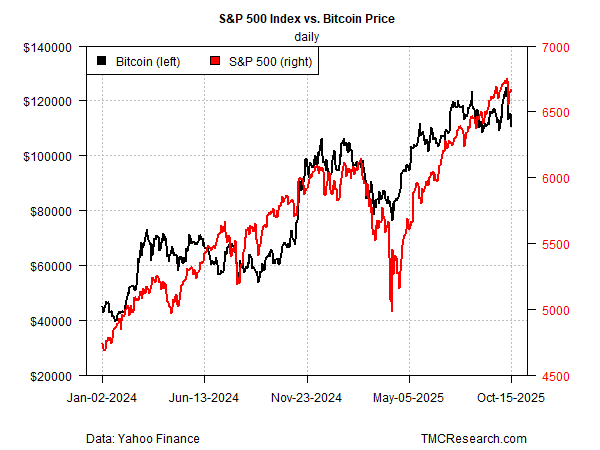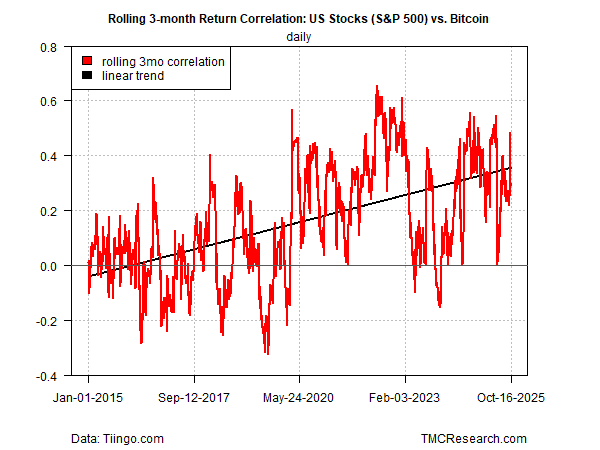Is Bitcoin’s Popularity Undermining Its Use For Hedging Stock Market Risk?
By James Picerno | The Milwaukee Company
Bitcoin’s returns increasingly align with shifts in the stock market
The cryptocurrency’s rising correlation with equities lessens bitcoin’s role as a diversification tool
Gold, by contrast, is shining this year as a safe-haven asset, effectively flipping the “digital gold” narrative promoted by cryptocurrency advocates on its head
Bitcoin may or may not become a global standard for digital payments in the years ahead, but it looks like a good proxy for assessing the financial market’s appetite for risk.
That’s good news for investors looking for alternative read on equity risk sentiment, but it could be problematic for using bitcoin as a hedge against stock market risk.
Back in March we noted that comparing the most-popular cryptocurrency with US shares (S&P 500 Index) suggests an increasingly tighter connection between bitcoin and sentiment on Wall Street. Seven months later, the connection between the two asset classes looks even tighter.
The latest example: When stocks tanked last Friday (Oct. 10), so did bitcoin, which lost substantially more that day vs. the S&P 500. Gold, by contrast, was up 1.0%.
One day could be noise, of course, but a review of bitcoin vs. stocks over the last several years confirms a tighter connection between the assets in recent history. For example, over the past three years, the daily returns for bitcoin and the S&P 500 posted a moderately positive 0.33 correlation, up from a slightly negative correlation in the previous three-year period. Note: perfect correlation (no diversification benefit) is indicated by 1.0; no correlation (random behavior) is 0.0; and -1.0 is perfect negative correlation (always moving inversely).
Although the cryptocurrency still exhibits a fair amount of return independence from stocks, the degree of low/negative correlation is fading as the asset moves into the mainstream of financial markets.
Monitoring risk sentiment
The upside of a higher correlation: there are times when bitcoin appears to offer contemporaneous, or early, signals of a change in risk sentiment for stocks. The digital asset’s downturn in early-2025, for instance, foreshadowed the subsequent slide in equities. Coincidence? Maybe, but something similar occurred again in April, when bitcoin bottomed around the time that the decline in stocks started to reverse.
These two events suggest that this crypto asset sometimes confirms, if not predicts, a change in investors’ risk appetite for stocks.
By contrast, bitcoin in its early days was seen as an independent asset, disconnected from traditional financial markets and the economy. That perception was largely attributable to the cryptocurrency ecosystem, which, historically, operated outside the mainstream of finance through a network of independent and predominantly offshore exchanges. But the growing embrace of the cryptocurrency by institutions, and easier access for individuals via publicly traded bitcoin funds, has tightened the ebb and flow between the two asset classes.
Correlation and Diversification
The rising correlation between bitcoin and stocks suggests that the digital currency has become somewhat less useful for diversifying equity risk, if only on the margins so far. Consider how a rolling 3-month window for daily returns has evolved. The linear trend shows the correlation approaching 0.4 (black line in chart below). That’s still well below correlations between, say, US large-cap stocks vs. small-caps, or US stocks and foreign equities. But if recent history’s a guide, bitcoin and stocks look set to become even more closely aligned in the future.
Bitcoin’s moderately positive correlation still offers a degree of independence from stocks, but the connection between the two assets is showing stronger alignment in periods of elevated stock market stress, such as during the spring correction. Bitcoin’s story as an investment class has continually evolved, from digital cash to a store of value, and later to a volatile, high-return vehicle. As its correlation with equity markets deepens, it is beginning to resemble a speculative asset more than the alternative store of value it was once touted to be.
It’s too soon to write off bitcoin as a diversifying force for stocks. Even if it’s more closely aligned with equities going forward, it may still be useful as a compliment for diversifying stock-market risk vis-a-vis other asset classes, such as bonds, commodities and property shares. But if 2025 is a guide, it seems that the crypto’s success in going mainstream is starting to conflict with its earlier image as an asset apart from the financial system’s status quo.




